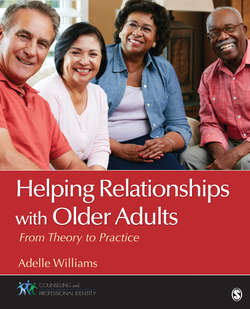Читать книгу Helping Relationships With Older Adults - Adelle M. Williams - Страница 37
На сайте Литреса книга снята с продажи.
Musculoskeletal System
ОглавлениеPsychological changes will accompany the natural changes in the musculoskeletal system of older adults. The changes will affect their emotional well-being, sense of security, living environments, self-esteem, and ability to function in all aspects of daily life. Older adults may fear falling due to loss of muscle mass and difficulty ambulating as a result. They may become isolated and fearful of having to move to an unfamiliar environment, which facilitates dependence on others. Older adults may perceive themselves in a negative manner because of any limitations imposed by the changes in the muscles and bones. Self-care and activities such as grocery shopping, driving, and handling financial transactions may not be managed by older adults. Fearfulness, anxiety, depression, social isolation, and low self-esteem are just some of the issues counselors will need to address to improve the quality of life for elders. Counselors must also evaluate the environment or make a referral for a home assessment to decrease any possibility of falls or other injuries. They must teach older adults how to cope with the consequences and/or diseases that they have developed. They must always focus on the strengths and abilities while providing the required resources to improve their quality of life.
There are three types of muscles in the musculoskeletal system: skeletal, cardiac, and smooth muscles. Skeletal muscle is a collection of striated muscle fibers connected at either or both extremities with the bony framework of the body. Cardiac muscle is an extremely specialized form of muscle tissue that has evolved to pump blood throughout the body. Smooth muscle fibers form the supporting tissues of blood vessels and hollow internal organs, such as the stomach, intestine, and bladder. The skeletal muscles make up most of the muscle content in the body and lose the most mass with aging. Muscle tissue and strength begin to decrease around the age of 30 and continue throughout the life span (Arking, 2006). With proper precautions, most older people retain enough muscle mass and strength to carry out everyday tasks. Lean muscle is the amount of weight you carry on your body that isn’t fat. When lean muscle mass decreases, it is caused by muscle atrophy. The decrease in hormones and testosterone that stimulate muscle development is a reason why muscle mass declines with age. Disuse and disease, as in many systems, are major confounders of age effect. One hypothesis is that disuse atrophy occurs, arguing for a “use it or lose it” construct. Age-related changes include loss of muscle mass, though strength loss can be relatively preserved by exercise (Besdine & Wu, 2008).
The size and number of muscle fibers decreases with age, which causes the muscle to respond more slowly. The muscles cannot contract as quickly because there are more muscle fibers in fast-contracting muscles than compared to the slow-contracting muscles. Sprinters require short but intense bursts of energy and therefore need more fast-contracting muscles, while postural muscles of the back are composed of slow-contracting muscles, and long-distance runners require more slow-contracting muscles (Aging Changes in the Bones, Muscles, and Joints, 2012). As the muscle mass decreases, fat content increases, which affects the body’s metabolic rate. This can make it harder to maintain a healthy weight and good cholesterol level (Arking, 2006). The change in the metabolic rate is the reason why older people do not metabolize medications as well.
The human body is a complex network of symbiotic systems. The skeletal system and the muscular system work together as the framework for the body as well as providing the pieces that allow for movement. The human skeleton consists of 206 separate bones that provide a solid frame to support the body, as well as protection for internal organs. The bones come together at joints, which allow for movement of individual limbs as well as movement of the entire body in conjunction with skeletal tissue and the muscular system. The muscular system is composed of over 600 muscles, which include involuntary muscles of the heart and the smooth muscle of the internal organs. The skeletal muscles connect to the bones and work with connective tissue at the joints to allow for movement. The muscles connect to the nervous system and allow initiation of movement through nerve signals to and from the brain (Hurd, 2014). The skeletal system gives strength and support to the body. It is also affected by age. As a person ages, the amount of cells present in cartilage decreases, and it loses its translucence. One of the most notable changes with the skeletal system is that of calcification and calcium deposits in joints and tendons, which sometimes contributes to inflammation, causing pain and limiting movement and sometimes causes soft tissues to harden. Calcium crystals can also contribute to the erosion of cartilage (Aging Changes in the Bones, Muscles, and Joints, 2012). The replacement of tissues like collagen decreases with age (Arking, 2006). Lipofuscin (an age-related pigment) and fat are deposited in muscle tissue. The muscle fibers shrink. Muscle tissues are replaced more slowly, and lost muscle tissue may be replaced with a tough fibrous tissue. This is most noticeable in the hands, which may look thin and bony (Hurd, 2014). Bone mass or density is lost as part of the aging process, and it is especially significant for women after menopause. The bones lose calcium and other minerals. The disks gradually lose fluid and become thinner in the spine, and vertebrae lose mineral content, which results in thinner bones. Foot arches become less pronounced contributing to a slight loss of height. Hip and knee joints, as well as finger joints, may begin to lose cartilage. Lean muscle mass decreases due partly to loss of muscle tissue (atrophy) (Hurd, 2014). Aging brings about changes in the musculoskeletal system that is essential for all movement, while the immune system is critical to fight against infections.
